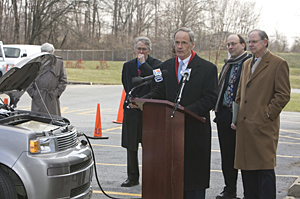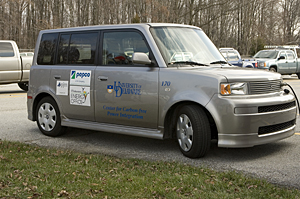

- Rozovsky wins prestigious NSF Early Career Award
- UD students meet alumni, experience 'closing bell' at NYSE
- Newark Police seek assistance in identifying suspects in robbery
- Rivlin says bipartisan budget action, stronger budget rules key to reversing debt
- Stink bugs shouldn't pose problem until late summer
- Gao to honor Placido Domingo in Washington performance
- Adopt-A-Highway project keeps Lewes road clean
- WVUD's Radiothon fundraiser runs April 1-10
- W.D. Snodgrass Symposium to honor Pulitzer winner
- New guide helps cancer patients manage symptoms
- UD in the News, March 25, 2011
- For the Record, March 25, 2011
- Public opinion expert discusses world views of U.S. in Global Agenda series
- Congressional delegation, dean laud Center for Community Research and Service program
- Center for Political Communication sets symposium on politics, entertainment
- Students work to raise funds, awareness of domestic violence
- Equestrian team wins regional championship in Western riding
- Markell, Harker stress importance of agriculture to Delaware's economy
- Carol A. Ammon MBA Case Competition winners announced
- Prof presents blood-clotting studies at Gordon Research Conference
- Sexual Assault Awareness Month events, programs announced
- Stay connected with Sea Grant, CEOE e-newsletter
- A message to UD regarding the tragedy in Japan
- More News >>
- March 31-May 14: REP stages Neil Simon's 'The Good Doctor'
- April 2: Newark plans annual 'wine and dine'
- April 5: Expert perspective on U.S. health care
- April 5: Comedian Ace Guillen to visit Scrounge
- April 6, May 4: School of Nursing sponsors research lecture series
- April 6-May 4: Confucius Institute presents Chinese Film Series on Wednesdays
- April 6: IPCC's Pachauri to discuss sustainable development in DENIN Dialogue Series
- April 7: 'WVUDstock' radiothon concert announced
- April 8: English Language Institute presents 'Arts in Translation'
- April 9: Green and Healthy Living Expo planned at The Bob
- April 9: Center for Political Communication to host Onion editor
- April 10: Alumni Easter Egg-stravaganza planned
- April 11: CDS session to focus on visual assistive technologies
- April 12: T.J. Stiles to speak at UDLA annual dinner
- April 15, 16: Annual UD push lawnmower tune-up scheduled
- April 15, 16: Master Players series presents iMusic 4, China Magpie
- April 15, 16: Delaware Symphony, UD chorus to perform Mahler work
- April 18: Former NFL Coach Bill Cowher featured in UD Speaks
- April 21-24: Sesame Street Live brings Elmo and friends to The Bob
- April 30: Save the date for Ag Day 2011 at UD
- April 30: Symposium to consider 'Frontiers at the Chemistry-Biology Interface'
- April 30-May 1: Relay for Life set at Delaware Field House
- May 4: Delaware Membrane Protein Symposium announced
- May 5: Northwestern University's Leon Keer to deliver Kerr lecture
- May 7: Women's volleyball team to host second annual Spring Fling
- Through May 3: SPPA announces speakers for 10th annual lecture series
- Through May 4: Global Agenda sees U.S. through others' eyes; World Bank president to speak
- Through May 4: 'Research on Race, Ethnicity, Culture' topic of series
- Through May 9: Black American Studies announces lecture series
- Through May 11: 'Challenges in Jewish Culture' lecture series announced
- Through May 11: Area Studies research featured in speaker series
- Through June 5: 'Andy Warhol: Behind the Camera' on view in Old College Gallery
- Through July 15: 'Bodyscapes' on view at Mechanical Hall Gallery
- More What's Happening >>
- UD calendar >>
- Middle States evaluation team on campus April 5
- Phipps named HR Liaison of the Quarter
- Senior wins iPad for participating in assessment study
- April 19: Procurement Services schedules information sessions
- UD Bookstore announces spring break hours
- HealthyU Wellness Program encourages employees to 'Step into Spring'
- April 8-29: Faculty roundtable series considers student engagement
- GRE is changing; learn more at April 15 info session
- April 30: UD Evening with Blue Rocks set for employees
- Morris Library to be open 24/7 during final exams
- More Campus FYI >>
10 a.m., Jan. 14, 2009----The City of Newark became the first electric utility in the United States to approve the use of an electric vehicle to store and provide power for the local electric grid on Friday, Jan. 9.
The vehicle, which runs on electricity alone, is specifically designed to store energy and improve grid reliability. University of Delaware researchers helped develop the concept, called Vehicle-to-Grid (V2G), by working with a consortium of industry partners over the past decade to establish the communications protocol between the vehicle and the grid operator.
Industrial partners in the consortium include Delmarva Power and its parent company Pepco Holdings Inc; PJM, the regional grid operator; California-based electric vehicle manufacturer AC Propulsion; and others.
The action was celebrated during a press conference held Monday, Jan. 12, on campus and attended by U.S. Sen. Thomas R. Carper (D-Del.) and U.S. Rep. Michael N. Castle (R-Del.)
With the City of Newark's approval, the University of Delaware team is now conducting V2G testing at two outlets within the city's service territory.
Willett Kempton, associate professor of marine policy in the University of Delaware's College of Marine and Earth Studies, explained how the technology benefits the grid operator. Currently, there is no energy storage built into the electric grid system, meaning that electricity usage and electricity generation must be simultaneous.
As fluctuating, non-dispatchable renewable sources, such as solar and wind power, become a larger fraction of our electric generation, energy storage will help grid operators smooth power output fluctuations.
“Wind tends to blow stronger at night when the electric load is low,” he said. “If electric vehicles charged at night with wind power, the grid operator could use the energy in the batteries, when vehicles aren't needed for driving and are plugged in, to help maintain grid reliability. The vehicle owner would then be paid for providing these energy services at a greater value than what they paid for the electricity.”
The City of Newark's approval process for V2G electric vehicles is similar to the process used to certify solar photovoltaic (PV) systems on residential rooftops.
In both cases, the city is responsible for ensuring that the energy source will not feed power back to the grid when the power lines are down.
This requirement is critical to maintaining the safety of line workers during a power outage.
The University of Delaware and Delmarva Power conducted initial testing of this safety requirement before the vehicle was thoroughly tested to IEEE standards at the National Renewable Energy Laboratory in Golden, Colo.
Sam Sneeringer, the city's assistant electric director, describes the reasoning behind the certification process by saying, “Solar PV systems and V2G vehicles are tested to the same standards and treated the same within the city's approval process because electricity from the car's batteries or from a solar panel is indistinguishable to the electric grid and presents the same potential safety risks to linemen.”
Kempton and his team of researchers plan on having a fleet of six vehicles by the end of 2009, two at the University of Delaware and four operated by the state of Delaware.
The test fleet will be used to demonstrate multiple V2G vehicles working together and supplying energy as a single power plant. The City of Newark's approval paves the way for larger-scale adoption of V2G electric vehicles nationwide, helping to advance the electric grid infrastructure and reduce consumption of oil.
For more about the V2G industrial consortium, visit the Mid-Atlantic Grid Interactive Cars Consortium Web site.
For more about the University of Delaware's College of Marine and Earth Studies, visit the Web site.
Article by Elizabeth Boyle and Scott Baker
Photos by Kathy Atkinson


